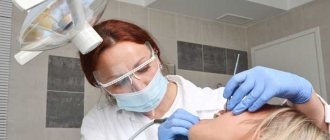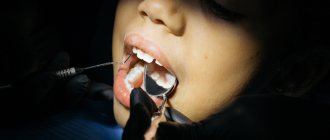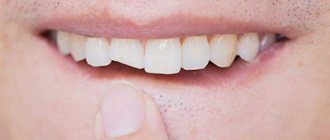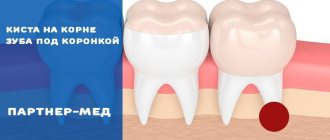From this article you will learn:
- in what cases is tooth resection performed?
- photo and video of the operation,
- tooth root resection: patient reviews, price 2022.
The article was written by a dental surgeon with more than 19 years of experience.
Root apex resection is a surgical method for treating granulomas and cysts that form at the root apex due to chronic inflammation (caused by infection in the root canals of the tooth). Granulomas and cysts are subtypes of a disease called chronic periodontitis.
They differ from each other only in size... If the inflammation at the root apex is more than 1 cm in diameter, the formation is called a radicular cyst, and if it is less than 1 cm, it is called a granuloma or cystogranuloma. Visually, they look like a “bag of pus” attached to the top of the tooth root.
Thus, the main indications for resection are the presence of an inflammatory focus at the apex of the tooth root, which is difficult to cure using conservative treatment methods for chronic periodontitis. The latter consists of temporarily filling the root canals with preparations based on calcium hydroxide (for a period of 2-3 months).
When is a tooth root 100% subject to extraction?
Tooth root removal is performed if:
- the root is softened below the gum level,
- the root of the tooth is below the level of the surrounding bone tissue,
- the root of the tooth has cracks
:
- the root of the tooth is chipped
:
- the root of the tooth is severely damaged, for example as a result of canal treatment with resorcinol
:
- There are various inflammatory processes around the root and under the root of the tooth - cyst, cystogranuloma
:
- the root of the tooth is mobile,
- there is a deep dental pocket.
Possible complications
Amputation of a tooth root can provoke a number of complications, which are expressed in different symptoms:
- Damage to adjacent teeth.
- Violation of the integrity of soft tissues.
- Inflammatory process.
- Swelling of soft tissues.
- Loss of sensitivity in the operated area of the jaw.
- Increased bleeding.
If there is suppuration in the wound at the operation site, you should immediately consult a doctor. In some situations, it is still necessary to remove the diseased tooth, since it is not always possible to stop the destruction of dental tissue from the inside.
How is tooth root removal done?
Are there any features or important points when removing a tooth root? Of course, any removal - be it tooth extraction, wisdom tooth removal, impacted tooth or tooth root should be carried out as atraumatically as possible, preserving the tissue structure
that surround a tooth or tooth root:
The goal of atraumatic root removal is to preserve bone
. Removal should be done painlessly.
The clinics of the German Implantology Center are supporters of atraumatic and painless removal. Our technologies have been proven over the years, and our patients feel very comfortable with them. It is no secret that many patients have fears about removal, and these fears sometimes postpone the surgical stage of treatment for a long time. In our clinics, we help patients overcome these fears. The patient may not be afraid of anything - both in the case of a single extraction and in case of multiple extractions of teeth
:
What is atraumatic tooth root removal?
What instruments does the surgeon use to achieve atraumaticity? For atraumatic removal, special instruments are used - thin, neat and elastic elevators that can minimally invasively penetrate and expand the periodontal tissue that connects the tooth root directly to the jaw. Using special instruments, the periodontal ligaments are cut so that the root can be removed as carefully as possible, in its “pure form.”
The vestibular plate that surrounds the bone is very thin. And we work with her carefully when removing teeth. It may also be necessary to saw the root of the tooth so that it can be removed in pieces. Sawing can be carried out with oscillating ultrasonic attachments - ultrasonic knives. Cutting the root of a tooth can be done quite effectively with a high-quality thin surgical dental bur, which has a certain length.
After cutting the root, the medial wall of the root is first removed, and then the vestibular wall of the root is removed. This allows for maximum preservation of surrounding tissue.
Then, after such removal, you can preserve the tooth socket or place an implant so that the bone is preserved as much as possible. Preservation of the tooth socket is carried out if there are no conditions for installing an implant at once, or if the patient undergoes delayed implantation.
If the roots of wisdom teeth are removed, the socket is not preserved; it is enough to remove them as atraumatically as possible. Let's talk about this in a little more detail.
Features of root removal of decayed wisdom teeth
Are there any difficulties when removing the roots of wisdom teeth? Removing the roots of wisdom teeth requires that the surgeon has sufficient experience. Often the roots of these third molars (wisdom teeth) are located close to the mandibular canal. Often the roots of molars are adjacent to the upper or lateral wall of the mandibular canal. The configuration of wisdom tooth roots is extremely diverse and sometimes extremely difficult to remove:
Therefore, when removing the roots of wisdom teeth, it is imperative that the patient undergo a CT scan. And the surgeon, as I said, needs to have some experience in surgical training in order to avoid the risks of removing the roots of such teeth and carry out the manipulation as efficiently as possible.
Like any root teeth, the roots of wisdom teeth are removed by cutting them along the roots. Wisdom teeth do not have problems because they are close to the angle of the lower jaw and there are strong cortical plates there. When I talked about thin vestibular walls, this comparison refers to the aesthetic zone of the smile, to the frontal group of teeth, including the premolars:
.
Removal techniques
The dental surgeon determines the extraction tactics individually for each patient. Takes into account the location of the tooth, the type of pathological process, and the degree of spread. Before extraction, the doctor sends the patient for an x-ray. The goal is to obtain accurate information about the roots and structural features of adjacent teeth and the jaw apparatus in which the pathological unit is located.
Simple operation
In the case of a conventional location, removal occurs in a simple way, which takes no more than 10 minutes, taking into account the effect of anesthesia. The dental surgeon performs the operation according to the following scheme:
- a preliminary survey of the patient about allergies to anesthesia drugs, chronic pathologies and the medications he uses;
- administration of a drug for superficial sedation in order to normalize the mental state and ensure a comfortable extraction process (at the request of the patient or according to indications);
- injection of a local anesthetic into nearby tooth tissues (gums, cheek), usually using ultracaine, which is considered hypoallergenic;
- after 4-5 minutes, the surgeon begins the removal process by loosening the tooth in the surrounding tissues;
- after ensuring mobility, the specialist separates the tooth from the gum and with a sharp movement turns it out of the alveolar socket;
- the wound is treated with an antiseptic solution;
- a tampon with a medicinal substance is applied to the wound, after which the bleeding stops for several minutes;
- if after tooth extraction the wound surface is too large, the doctor will apply several stitches, which will prevent the possibility of postoperative infection and bleeding in the future;
- the patient receives recommendations and goes home after stabilizing his physical and emotional condition.
After removal using a simple method, the patient feels well. If the wound bothers you after the anesthesia wears off, it can be easily eliminated by following your doctor's recommendations.
The hard way
When the doctor sees abnormalities on the x-ray, removal will be carried out in a complex way. The experience and skill of the doctor matters.
Stages in complex removal:
- taking anamnesis;
- choice of anesthesia;
- mandatory administration of sedatives to relieve tension in the patient;
- injection of local anesthesia into 5-6 areas surrounding the tooth to be removed;
- the doctor makes an incision in the gum to access the tooth and roots;
- drilling into several parts using a drill for easy removal and prevention of injury;
- the tooth is separated from the gum in parts and removed;
- a mandatory revision of the resulting hole is performed;
- the wound is treated with an antiseptic and sutured;
- To prevent infection and bleeding, the doctor places a drug or PRP membrane in the wound. They dissolve along with the sutures.
Extraction during the normal course of the process takes 20-30 minutes. If the operation is complicated, the procedure may take up to 2 hours. After a complex removal, the wound is wider, the tissue is more traumatized, the pain is more pronounced and lasts longer.
It is important that removal is carried out carefully, taking into account future implantation. Therefore, it is better to entrust the operation to an experienced maxillofacial surgeon who will not damage the alveolar ridge. In this case, you will not have to build up bone tissue before installing the implant and eliminate possible complications. Average surgeons usually do not stand on ceremony during operations. The result is broken bone structures of the jaw, wandering remnants of roots, unremoved cysts growing into the maxillary sinus, perforations, fistulas, osteomyelitis and much more. Not to mention the shocking post-operative pain that overtakes the patient after such punitive surgery. Only the maxillofacial surgeon has enough theoretical and practical skills to perform tooth extraction without complications.
What the patient needs to understand before root removal
You need to assess the health risks, you need to talk to the attending surgeon, find out about his experience. Quite often, tooth root removal is carried out, unfortunately, with the following negative consequences:
- gums are torn
- fractured bony vestibular plate
Sometimes when visiting such patients, you get the feeling that the tooth was not removed, but knocked out with something. There were cases when a patient’s extraction began in some clinic, and there, in the middle of the patient’s appointment, the doctor announced that he was unable to remove it, and the patients came to us in this form to remove the root of a tooth that was already in the extraction stage.
When removing the roots of wisdom teeth, you may face risks such as jaw fracture. One of the common risks of removing the roots of 3 molars is damage to the mandibular nerve
, leading to cuts and numbness in areas of the jaw. There is a risk of damaging the artery on the lingual side.
If, when a tooth is removed, a root or part of it is left behind, what should you do?
According to Russian treatment standards, the tooth root cannot be left during extraction. That is, if the patient was left with a root or part of it during removal, then this is considered a poorly performed surgical procedure.
In European countries there are doctors who agree that if there is no inflammation on the tooth and if the root part is not infected, and removal of the root leads to trauma, then only the cortical part of the root is removed, and the other part remains in the bone.
If the patient is left with a part of the root that is infected, then this is a problem. A cyst may develop and inflammation may develop. If the apical part was not infected, then everything heals and does not bring any trouble to the patient.
Tooth root without crown part
Can a tooth root without a crown cause inflammation in the gums or bone? Of course it can. There is a canal at the root of the tooth; if this canal is infected, then the problem will develop into a negative prognosis.
Inflammation, suppuration, periostitis, osteomyelitis - diseases can develop due to an infected tooth root. And the source of infection at the root must be removed; if it is impossible to remove the infection and preserve the root, then it must be removed.
Contraindications
This list looks like this:
- serious somatic diseases (diabetes mellitus, malignant tumors, pathologies of the cardiovascular system, etc.);
- the need to preserve root canals;
- obstruction of root canals;
- root fusion;
- bone resorption;
- elderly age.
Along with this, performing root hemisection should not cause damage to adjacent teeth. Another important point is the possibility of allergic reactions in the body. We are talking about the rejection of the artificial material with which the root canal is filled. Such situations are very rare, but they cannot be discounted categorically. Otherwise, the postoperative period will be significantly delayed and will bring serious complications.
Is implantation possible after tooth root removal?
Yes, of course it is possible. And we at the clinics of the German Implantology Center widely use implantation after tooth root removal. Our conditions allow us to carry out implantation in such cases. And if we can achieve primary stability of the implant, then in 90% of cases
After removal, we immediately install the implant. We have rolled out the technology to perfection and gives excellent results.
Of course, with the exception of wisdom teeth, no implant is placed after their removal. But, by the way, wisdom teeth in this situation can be extremely useful, since they... can be transplanted to the place of the problem tooth being removed! Dental transplantation has been practiced in the clinics of the German Implantology Center since 2017, and our specialists have accumulated a wealth of clinical experience. Let's talk about this a little more.
An alternative to implantation is autotransplantation of wisdom teeth
Don't rush to remove your wisdom teeth. Firstly
, there must be clear indicators for their removal.
Secondly
, you don’t need to follow fashion, trends and delete eights just because “a girlfriend or friend deleted them and it’s cool.” There are a number of moments in life when wisdom teeth come to our aid.
It is not for nothing that nature has created a number of organs that duplicate each other in our body, for example, we have two lungs, two kidneys, which in case of problems with one lung/kidney come to our aid. Also with wisdom teeth: if a person (for some reason) has problems with the chewing group of teeth, for example, caries has destroyed the sixth or seventh tooth, then eights can come to the rescue. How so? After all, wisdom teeth are not involved in the chewing process. Yes, you are right here. But a wisdom tooth can serve as a donor, and it can be transplanted into place of a tooth with destroyed roots. Fantastic? No, advanced technologies in dentistry. This is called autotransplantation.
In the following video we show in detail the dental transplant surgery. The roots of two sixths of the patient's teeth had just been destroyed, and they were replaced by the patient's own wisdom teeth. And, by the way, this patient at the end of the video gives a detailed review after 1 year after the operation. Look, this is useful:
Rehabilitation period
After the procedure, the patient may feel pain. Painkillers prescribed by your doctor will help reduce it. It is also necessary to strictly follow all the dentist’s recommendations to make the healing process faster, take prescribed medications, and carefully observe oral hygiene. For three days after surgery, it is strictly forbidden to rinse your mouth.
For the first time after surgery, you can eat only soft foods, trying not to injure the damaged area. It will be important to stop smoking tobacco and drinking alcoholic beverages.
It is recommended to exclude baths, saunas, and not take hot baths for several days. If you heat the procedure site, bleeding may begin. If this does happen, it is necessary to apply a cold, wet cloth or ice, which will constrict the blood vessels and quickly stop the bleeding.











